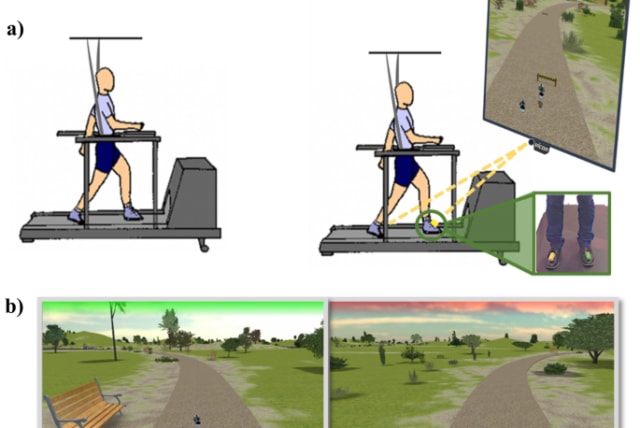Training on treadmill with VR can help MS patients - study

About 100 MS patients aged 18 to 65 participated in the study.
Training on a treadmill and using virtual reality (VR) may improve walking and cognition and relieve depression among relapsing-remitting multiple sclerosis (MS) patients, according to a new study.
Led by researchers at Tel Aviv’s Sourasky Medical Center and the Sackler Medical Faculty at Tel Aviv University (TAU), it was conducted with colleagues at The University of Kansas and Charité Hospital of the University of Berlin.
About 100 MS patients aged 18 to 65 participated in the study, some of whom were recruited from the multiple sclerosis clinics of Prof. Arnon Karni, head of the hospital’s neuroimmunology department, and Dr. Keren Regev, the head of its MS service.
The study showed that six weeks of walking training on a treadmill improves the walking speed with and without an additional task, and the addition of VR while walking contributes to further cognitive improvement and a decrease in depression among subjects with relapsing-remitting MS.
It was the largest randomized-controlled study to demonstrate that treadmill training with or without the addition of a VR component positively affects several aspects of MS patients’ gait and mobility.
MS is the most common acquired chronic neurological disease affecting young adults, are often diagnosed between the ages of 20 to 40. Although there are treatments to slow the patient’s decline, there is no known cure.
There is no known single cause of MS, but many genetic and environmental factors have been shown to contribute to its development.
In MS, the body’s own immune system mistakenly attacks and damages the fatty material – called myelin – around the nerves. Myelin is important for protecting and insulating nerves so that the electrical messages sent by the brain to the rest of the body travel quickly and efficiently.
As the myelin breaks down during an MS attack – a process called demyelination – patches of nerves become exposed and then scarred, which render the nerves unable to communicate messages properly, putting them at risk of subsequent degeneration – like an electric wire without insulation. This means that the brain cannot talk to other parts of the body, resulting in a range of symptoms that can include loss of motor function – such as walking and hand and arm function– loss of sensation, pain, vision changes and changes to thinking and memory.
The relapsing-remitting type is the most common, where the patient has symptoms that get worse followed by recovery. The disability doesn’t get worse between relapses, but after each relapse, it can end up worse than before.
The most common relapsing symptoms include episodic bouts of fatigue, numbness, vision problems, spasticity or stiffness, bowel and bladder problems and problems with cognition – learning and memory or information processing.
MS patients also suffer decline in cognitive ability
IRINA GALPERIN, currently a doctoral student at TAU’s Faculty of Medical Sciences, and Prof. Jeffrey Hausdorff of Sourasky’s Center for the Study of Movement, Cognition and Mobility, explained that such MS patients not only have problems with walking and other physical functions, but some suffer from a decline in cognitive ability, which may include memory, executive functions and more.
Improving mobility capabilities – such as walking speed and walking while doing another task – as well as improving cognitive abilities, can lead to a significant improvement in their quality of life.
The multi-center study has just been published in the Journal of Neurology under the title “Treadmill training with virtual reality to enhance gait and cognitive function among people with multiple sclerosis: A randomized controlled trial.”
The effect of walking on a treadmill versus doing so along with VR was tested on various functions, such as walking with and without an additional task. Some 51 subjects exercised using a treadmill with the guidance of an attached physical therapist, and 53 exercised on a treadmill with the addition of a virtual reality system projected on a screen in front of them that required crossing “virtual” obstacles, navigation and more while walking.
The training sessions were carried out three times a week for six weeks. The participants arrived at the Tel Aviv Medical Center and three others in the US and Germany before, one week after, and three months after the end of the intervention.
Both groups improved walking speed by about 10%, pace and other walking metrics whether or not they walked with or without an additional task following the training. Subjects who trained with the addition of VR showed a decrease in the speed of cognitive loss and in depression level, as well as improvement in additional measures of cognition.
After three months, some of the benefits such as faster walking and better cognition that were achieved during the training period were still preserved.
This type of training, said the researchers, could be an alternative to supportive drug treatment for sclerosis patients suffering from cognitive problems and depression. It was also found that patients who are able to walk for five minutes in a row, whether they have a mild or serious case of MS, can improve equally from the exercise.
Jerusalem Post Store
`; document.getElementById("linkPremium").innerHTML = cont; var divWithLink = document.getElementById("premium-link"); if (divWithLink !== null && divWithLink !== 'undefined') { divWithLink.style.border = "solid 1px #cb0f3e"; divWithLink.style.textAlign = "center"; divWithLink.style.marginBottom = "15px"; divWithLink.style.marginTop = "15px"; divWithLink.style.width = "100%"; divWithLink.style.backgroundColor = "#122952"; divWithLink.style.color = "#ffffff"; divWithLink.style.lineHeight = "1.5"; } } (function (v, i) { });

